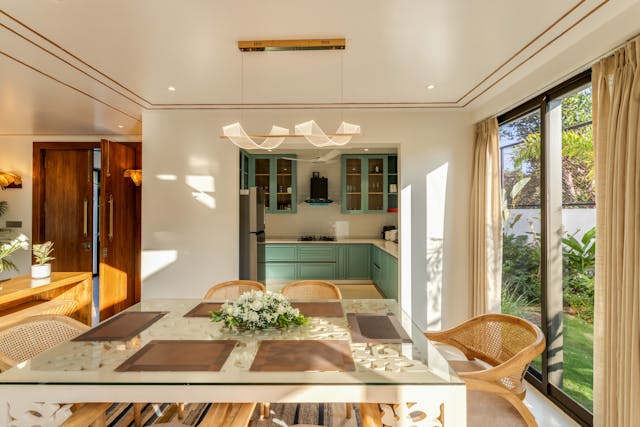There’s nothing like walking into a brand-new home, full of possibilities and ready to be shaped into your own. The blank walls and open rooms invite creativity, but here’s the catch: most homeowners focus only on surface details like colors and décor. While those matter, the real magic happens with smart space planning.
Thoughtful planning transforms a house from simply looking good to truly working for you, bringing comfort, flow, and functionality to every corner. That’s the difference between a home that feels cramped and one that feels effortlessly welcoming and practical.
Essential Principles of Smart Home Layout Ideas
You’ve probably walked through homes that just *feel* right, haven’t you? There’s a secret behind that magic, and it starts with understanding some fundamental truths about how spaces work.
The Psychology of Space Flow and Movement
Think about water flowing down a river; it follows the path of least resistance. People move through homes the same way. When you fight against these natural patterns with awkward furniture placement, you’re creating rapids in your living room.
Your home layout ideas should work with human instincts, not against them. Watch how your family moves during busy mornings. Where do bottlenecks happen? Those spots need your attention first.
Here’s what matters: successful layouts feel effortless. You shouldn’t have to squeeze past the coffee table every single time you want to reach the bookshelf.
Measuring and Mapping Your Available Square Footage
Lots of money. You need accurate measurements before you commit to any layout decisions.
Don’t just measure floor space. Document everything: ceiling heights, electrical outlets, plumbing locations, and window swings.
When you’re planning major projects like professional concrete pouring for integrated patios, precise measurements become critical. You need proper drainage calculations and seamless indoor-outdoor transitions.
Identifying Your Family’s Lifestyle Patterns and Needs
Magazine-perfect layouts look stunning in photos. But do they work for *your* family? Probably not.
Empty nesters have completely different needs than households juggling soccer practices and homework sessions. Multi-generational families? That’s another story entirely.
Take notes for a week. Where do problems happen? Do you constantly hunt for storage space? Does your current furniture create awkward traffic jams? These observations become your blueprint for smart spacing solutions that actually solve real problems.
Revolutionary Open-Concept Space Optimization Tips
Open-concept living isn’t just a trend; it’s a response to how modern families live. But pulling it off successfully? That requires more finesse than just knocking down walls.
Creating Defined Zones Without Physical Barriers
You can establish distinct areas using clever space optimization tips that don’t involve construction. Area rugs become invisible boundaries for conversation spaces. Strategic lighting marks dining zones.
Color changes and ceiling treatments create psychological separation.
The beauty lies in maintaining visual flow while giving people comfortable, defined spaces. It’s like having your cake and eating it too.
Strategic Furniture Placement for Maximum Flow
Here’s a radical idea: pull your furniture away from the walls. Seriously. Floating pieces often create better circulation than traditional perimeter arrangements, especially in new home design scenarios where you’re starting fresh.
Consider sightlines carefully. That perfectly positioned sofa can direct attention toward your fireplace while keeping pathways clear. It’s choreography for your living space.
Incorporating Flexible Partition Solutions
Sometimes you need privacy without permanent walls. Sliding panels, rolling bookcases, and curtain systems provide adaptability as your needs evolve.
Planning these systems during initial construction saves serious money. Installation labour by a technician could cost up to $120 per hour, which is another reason to have your renovation team install for you, especially as you continue to add smart appliances and features to your home.
Multi-Functional Room Design Strategies
Single-purpose rooms are luxury items most of us can’t afford. The smart move? Make every space pull double duty without looking like you’re trying too hard.
Dual-Purpose Living Spaces That Work Overtime
Guest rooms that transform into home offices. Kitchen islands serving as prep areas, dining spots, and homework stations. Murphy beds that disappear when you need floor space for yoga.
This approach makes interior layout planning incredibly efficient. You’re essentially getting more house without adding square footage.
Hidden Storage Integration Techniques
Built-in storage maintains clean aesthetics while solving organization challenges. Window seats hide seasonal items. Staircase drawers utilize dead space. Toe-kick cabinets maximize kitchen storage without visual clutter.
The best solutions feel invisible until you need them. That’s the mark of truly thoughtful design.
Transformative Furniture Solutions for Small Spaces
Nesting tables. Expandable dining surfaces. Modular seating systems. These pieces adapt to different situations without overwhelming smaller rooms.
Look for furniture with natural multi-purpose functionality. Storage benches, console tables with shelving, and lift-top coffee tables maximize utility while maintaining attractive appearances.
Vertical Space Maximization Techniques
Most people think horizontally when planning layouts. Smart designers think up.
Floor-to-Ceiling Storage Solutions
Tall cabinets and shelving systems create illusions of greater space while providing substantial storage capacity. This works especially well in kitchens and home offices where organization matters most.
Custom built-ins integrate seamlessly with existing architecture. Professional installation ensures proper weight distribution, safety first, always.
Mezzanine and Loft Integration Ideas
Half-floors and loft spaces add functional square footage without expanding your home’s footprint. Perfect for offices, reading nooks, or additional storage that doesn’t feel cramped.
Access methods matter tremendously. Spiral staircases save floor space but limit furniture movement between levels. Choose wisely.
Staircase Design as Functional Art
Modern stairs can incorporate storage, lighting, and display areas. Under-stair spaces become pantries, powder rooms, or cozy reading corners, spaces that would otherwise go unused.
Floating stairs create visual lightness while maintaining structural integrity. They keep sight lines open in multi-level layouts.
Smart Kitchen and Dining Interior Layout Planning
Your kitchen works harder than any other room in your house. It deserves thoughtful planning that matches its importance.
The Work Triangle Reimagined for Modern Homes
The traditional work triangle between sink, stove, and refrigerator still provides value, but modern cooking requires more sophisticated planning. Multiple prep zones, specialized appliances, and coffee stations. These additions change everything.
Consider how you actually cook. Do you bake frequently? Need a dedicated beverage center? These requirements impact traffic flow and storage throughout your kitchen.
Island vs. Peninsula: Choosing Your Space Optimizer
Islands provide 360-degree access but demand significant floor space. Peninsulas offer similar functionality while using less space and providing additional cabinet storage below.
Your choice depends on available space, traffic patterns, and intended uses. Both can incorporate seating, storage, and specialized features successfully.
Bedroom and Private Space Optimization
Private spaces need different considerations than public areas. They’re about rest, functionality, and personal sanctuary, all at once.
Master Suite Layout Strategies for Luxury and Function
Walk-through closets connecting bedrooms to bathrooms create hotel-like experiences while maximizing storage efficiency. This layout provides natural separation between sleep and grooming areas.
Seating areas within master suites offer retreat spaces without leaving the bedroom. Window seats, chaise lounges, and small conversation areas enhance comfort significantly.
Common Questions About Smart Home Spacing
- What’s the ideal square footage per person in a new home layout?
Generally, 600-700 square feet per person provides comfortable living, though smart design can make smaller spaces feel much larger through strategic planning.
- How do you determine the best room flow for a family of four?
Map daily routines and identify conflict points where family members’ paths cross awkwardly, then adjust furniture placement to create smoother traffic patterns.
- Can you create an open floor plan in any existing home structure?
Most homes can accommodate some openness, but load-bearing walls require professional evaluation before removal to ensure structural integrity remains intact.
Making Your Space Work Smarter
Smart spacing isn’t about rigid rules or perfect Instagram photos. It’s about understanding how your family lives and designing around those honest realities. The most successful layouts blend functionality with beauty, creating homes that adapt as your needs evolve.
Whether you’re building new or renovating existing space, thoughtful planning transforms any house into a perfectly tailored home. One that works as hard as you do, looks as good as you dreamed, and feels exactly like home should feel.




